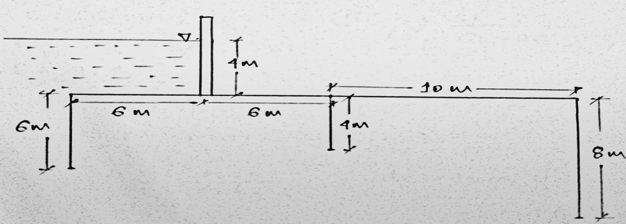This set of Irrigation Engineering Multiple Choice Questions & Answers (MCQs) focuses on “Seepage Theories – Bligh’s Creep Theory”.
1. What is the value of Bligh’s coefficient for coarse-grained soil?
a) 15
b) 12
c) 5 to 9
d) 8
View Answer
Explanation: The value of Bligh’s creep coefficient (C) is different for different soil.
| S.No. | Type of soil | Value of C |
|---|---|---|
| 1. | Micaceous sand | 15 |
| 2. | Coarse-grained soil | 12 |
| 3. | Sand mixed with boulder and gravel and for loam soil | 5 to 9 |
2. For sand mixed with boulder and gravel and for loam soil, the safe hydraulic gradient should be ___________
a) 1/15
b) 1/12
c) 1/5 to 1/9
d) 1/8
View Answer
Explanation: For Micaceous sand, the safe hydraulic gradient is less than 1/15 and for Coarse-grained soil is 1/12. For light sand and mud, the safe hydraulic gradient should be less than 1/8.
3. Which of the following is not a limitation of creep theory?
a) No distinction between the vertical and horizontal creep
b) No distinction between effectiveness of outer and inner faces of sheet pile
c) Significance of exit gradient is not considered
d) Only a nominal floor thickness is required on the upstream side so as to resist water
View Answer
Explanation: The thickness is generally increased by 33% so as to allow a suitable factor of safety. The water on the upstream side is more than the downstream side and it counterbalances the uplift caused on that side. Hence, only a nominal thickness is required.
4. If the value of Bligh’s coefficient for a particular soil is equal to 12 then, what is the safe hydraulic gradient for that soil?
a) 1/12
b) 1/9
c) 1/15
d) 1/5
View Answer
Explanation: The hydraulic gradient i.e. HL/L is equal to the coefficient of creep 1/C.
Bligh’s coefficient = 12
So, safe hydraulic gradient = 1/12.
5. According to Bligh, a vertical cut-off at U/s end of the floor is less useful than the one at the D/s end of the floor.
a) True
b) False
View Answer
Explanation: The worst condition is that when the water level on U/s side is maximum and no water on D/s side. It would be more economical to provide more creep length on U/s side instead of D/s side. A vertical cut-off at U/s end is more useful than at the D/s end of the floor.
6. Consider the following statements about Bligh’s Creep Theory.
i. Creep length is the length of path traversed by percolating water
ii. To increase the path of percolation vertical cut-off or sheet piles can be provided
iii. Loss of head per unit creep length is hydraulic gradient
iv. Bligh gave no criteria for the safety of weir against undermining
Which of the following statements are correct?
a) i, ii, iii
b) ii, iii, iv
c) i, iii, iv
d) i, ii, iv
View Answer
Explanation: According to the theory, safety against piping can be ensured by providing sufficient creep length. It is given by –
L = CH where, C = Bligh’s coefficient and H = seepage head
OR
Hydraulic gradient (i) ≤ 1/C.
7. As per Bligh’s theory, thickness to be provided by taking a factor of safety equal to _______
a) 2/3
b) 4/3
c) 1/3
d) 1/2
View Answer
Explanation: The thickness to be provided by taking a factor of safety of 4/3 i.e.
Thickness (t) = 4/3 x h / (G-1) where h = ordinate of HGL from top of floor and G = specific gravity of floor material.
8. Calculate the value of creep length for the following.

a) 50 m
b) 26 m
c) 58 m
d) 36 m
View Answer
Explanation: Total creep length, L = b + 2(d1 + d2 + d3)
d1 = 6 m, d2 = 4 m, d3 = 8 m and b = 22 m
L = 22 + 2 x (6+4+8) = 58 m.
Sanfoundry Global Education & Learning Series – Irrigation Engineering.
To practice all areas of Irrigation Engineering, here is complete set of 1000+ Multiple Choice Questions and Answers.
If you find a mistake in question / option / answer, kindly take a screenshot and email to [email protected]
- Check Civil Engineering Books
- Check Agricultural Engineering Books
- Apply for Agricultural Engineering Internship
- Practice Civil Engineering MCQs
- Apply for Civil Engineering Internship
